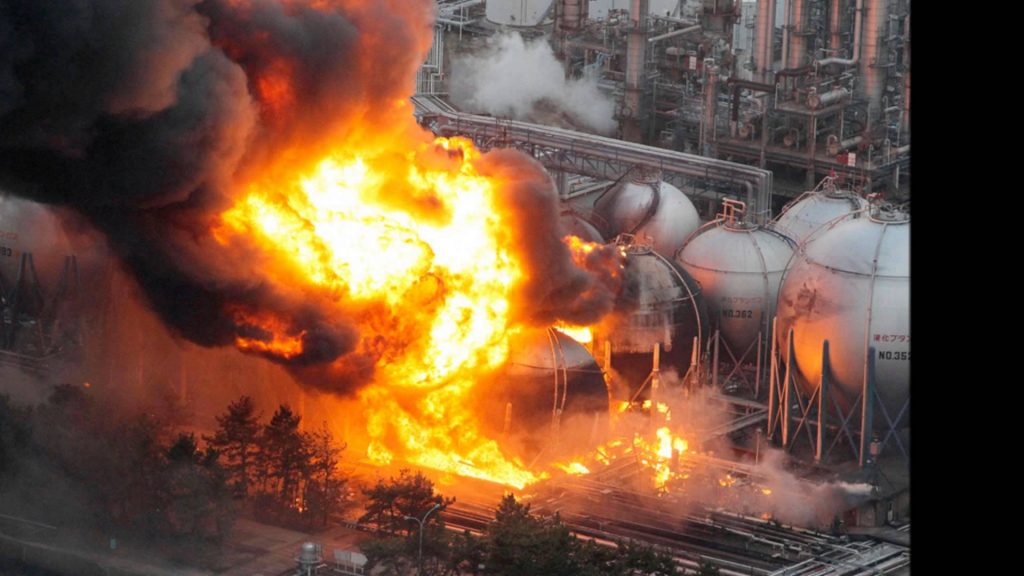Natural disasters are very common but tragic events around the world. From earthquakes to tornadoes, geological disasters can cause increasingly damaging effects, affecting the landscape and those who find themselves there. But when these events are combined with man-made artifacts, the effects might be even greater. An example of this is the Fukushima Disaster in Japan, the worst nuclear disaster since the 1986 Chernobyl incident.1 But the cause of this horrific disaster wasn’t particularly a man-made event. In fact, it all started with a wave.

On March 11, 2011, an earthquake with a magnitude 9.0—the worst to ever hit Japan—hit the country. It was such a powerful catastrophe, that Japan’s main island, Honshu, was permanently moved more than two meters to the east. As the earthquake gained momentum, waves up to 40 meters began crushing the country’s coast. The effects of the earthquake and the waves were too much for the Japanese. More than 20,000 people died or went missing and hundreds of thousands more lost their homes.2 But the worst was yet to come. Fifty minutes after the initial earthquake, a ten-meter high sea wall hit the Fukushima Daiichi (Number One) nuclear power plant. The water flooded the plant’s emergency power generators, knocking vital cooling systems offline, triggering a meltdown of reactor fuel rods. These then leaked deadly radiation into the coastal atmosphere of Japan. With the cooling systems not working, hydrogen gas built up in the reactor buildings, causing several hydrogen explosions in the following days of the earthquake.3

Because of the highly toxic radioactive material that leaked to the surrounding areas of the power plant, the government began to evacuate 80,000 people from a twelve-mile radius. Technicians turned to several things to try to cool the nuclear fuel, like using fresh water, seawater, and injecting nitrogen into the reactor containment buildings to prevent further explosions.4 But despite the efforts to try to help the people of Honshu, the government didn’t tell the people the truth. The official statistics of the event and even the admittance that the meltdown had taken place weren’t disclosed until eighty-eight days later.5
It was estimated that more than 800,000 tons of highly-radioactive material sat near the accident, which was slowly getting into the ground and moving towards the ocean. Although many people were evacuated, there were still many that couldn’t leave. The government installed temporary housing that was intended to house tens of thousands of people after the disaster for twenty-four months. But five years after the disaster, thousands of people were still living where they were surrounded by the radioactive material. Many of those who remained were the elderly and low-income families who had few options to move away.6

Several months after the disaster, people in other parts of Japan began rallying to help these people and bring an end to nuclear power plants in Japan. This pushed forward for the closure of all of the other nuclear plants in Japan for maintenance and inspection.7 These protests also pressured the government to issue a report on the disaster at Fukushima. This report criticized TEPCO (the Tokyo Electric and Power Company) for failing to address concerns about safeguards at the plant. This report also included information about how TEPCO officials had ignored engineers’ concerns that a seawall constructed to protect against major tsunamis as they had seen on March 11 was not sufficient. The report additionally criticized safety regulators for not implementing proper safety measures and for failing to adopt global nuclear safety standards.8 This was really important for the Japanese because TEPCO had always emphasized that the nuclear generators were “fail-safe,” that the facility was completely earthquake resistant and that the reactors would be able to withstand a major tremor.9
Five years after the disaster in Japan, several policies were changed to address the rising concerns of the Japanese population regarding nuclear power plants. The major decision of this kind was the decision to phase-out nuclear power plants during the 2030s as part of Innovative Strategy for Energy and the Environment adopted by the cabinet of the Democratic Party of Japan (DPJ).10 TEPCO is still facing criticism regarding the amount of nuclear material that was leaked into the environment and it is estimated that cleanup operations could take up to forty years.11
- Will Ripley, Junko Ogura, and James Griffiths, “Fukushima: Five Years after Japan’s Worst Nuclear Disaster,” CNN, March 11, 2016, sec. World. ↵
- Encyclopedia Britannica, 2018, s.v. “Fukushima Accident.” ↵
- New World Encyclopedia, 2017, s.v. “Fukushima nuclear disaster.” ↵
- New World Encyclopedia, 2017, s.v. “Fukushima nuclear disaster.” ↵
- Will Ripley, Junko Ogura, and James Griffiths, “Fukushima: Five Years after Japan’s Worst Nuclear Disaster,” CNN, March 11, 2016, sec. World. ↵
- Will Ripley, Junko Ogura, and James Griffiths, “Fukushima: Five Years after Japan’s Worst Nuclear Disaster,” CNN, March 11, 2016, sec. World. ↵
- New World Encyclopedia, 2017, s.v. “Fukushima nuclear disaster,” ↵
- Encyclopedia Britannica, 2018, s.v. “Fukushima Accident.” ↵
- Akira Nakamura and Masao Kikuchi. “What We Know, and What We Have Not Yet Learned: Triple Disasters and the Fukushima Nuclear Fiasco in Japan,” Public Administration Review 71, no. 6 (2011): 894. ↵
- Rie Watanabe, “After the Fukushima Disaster: Japan’s Nuclear Policy Change from 2011 to 2012,” Review Of Policy Research 33, no. 6 (2016): 623. ↵
- Alexis Dudden, “The Ongoing Disaster,” The Journal of Asian Studies 71, no. 2 (2012): 349. ↵




111 comments
Emily Jensen
Nuclear power plants are extremely dangerous and, in my opinion, are located too close to populated areas. Even today, if another meltdown were to occur, you would see the same casualties due to the fact that there would not be enough time to evacuate the surrounding areas. Learning that cleanup operations could take up to forty years should be warning enough to the rest of the world to start phasing out their own nuclear power plants.
Nathan Alba
I had heard of the power plant exploding after the earthquake and tsunami, however I was unaware of the fact that the government had been withholding information from the people. This is terrible, the government put many people at risk by waiting eighty eight days to disclose that there had in fact been a meltdown. On top of that, the fact that they couldn’t evacuate everyone in the surrounding area left many people living in surrounding areas of the 800,000 tons radioactive waste.
Bictor Martinez
This article was extremely informative. I heard something about this event that occurred in Japan when I was younger, but reading this article helped me learn all the details that occurred at the event. Being exposed to the radiation can be extremely dangerous. Luckily, thousands of people were able to escape from the radiation thanks to Japan’s government quick reactions, however not all were able to make it out alive. This disaster should not be a wake up call to only Japan, but to other countries around the world to be more cautious about where they place their nuclear power plants.
Reagan Meuret
This article is a great read as I never knew the ensuing damage after the horrible 9.0 earthquake. Japan has gone through some horrific radioactive problems throughout the years, so I could see why its citizens would want the factories to go away. I just hope that these poor people dont ever go through these man made disasters right after a horrible natural disaster ever again.
Indhira Mata
We as people are adding to the destruction to the natural disasters already occurring. The government in Japan only thought about the project at the moment and did not think about the consequences as it turned out to be long term. Government tends to avoid considers in order to keep building anything in any space. Even the citizens notice this. The Government should address the people as it is for their behave they run for.
Eric Ortega Rodriguez
This article was extremely informative, I have never heard about The Fukushima Disaster until now. I did not know that Japan went through this nuclear disaster nonetheless that it was still affecting Japan today. I find it so sad how long it took for the government to release official information to its citizens. I cannot imagine what citizens were going through knowing that they could be affected by any contact of the highly toxic radioactive material. This event can also be eye-opening, not only in Japan but in all countries, to be more cautious when constructing nuclear power plants, this way, ensuring everyone’s well-being.
Kacey Diaz
This is crazy for me to read about because I lived in Japan for 8 years and I had moved to the United States 4 months before the disaster happened so I had friends who were still in Japan who were affected by this. The article itself is really well written and it goes over the disaster and the damage that happened due to the tsunami and the radiation from the power plant.
Ysenia Rodriguez
This article was well written and the title captured my attention right away. I can not imagine how it must have felt for the citizens of Fukushima to be evacuating from their houses, leaving behind all their personal and priceless belongings, without officially knowing that a nuclear plant meltdown was taking place until eighty-eight days after the event. The fact that this disaster all started with an actual wave, something they could not have stopped during an earthquake, is frightening.
Ethan Rodriguez
I think that this article was written greatly. I enjoyed every detail you used in your article, and when it came to the facts, I was absolutely taken at the sheer power of the environment. I like how the author referenced this disaster to the nuclear accident in Chernobyl, it allowed for the article to grip me that much more. It also brought this sense of worry, even though the event had already passed, I was saddened at the people that had once inhabited the island. Overall, this is one of the articles I really enjoyed reading and the writing style really grasped me and gave my inner reading a delightful read.
Madison Downing
Wow, this article was so fantastically written, and when you used your title in the first paragraph, incredible! I had no clue that the main island was moved 2 meters from its original spot, the power behind this tsunami is unbelievable for those not there to experience it. Also when the destruction of the nuclear plant was on the same level as Chernobyl was even worst, my heart is breaking for those people who still had to live there. It must have been so terrifying knowing the air could be killing you and how the company ignored concerns before this happened showing that some of the disaster could have been prevented, I really hope they are paying for their mistakes. I truly hope that Japan can fully recover from this and the environment as well, it is so satisfying to hear that Japan is trying to go nuclear free and is cleaning up the mess (even though it will take 40 years).